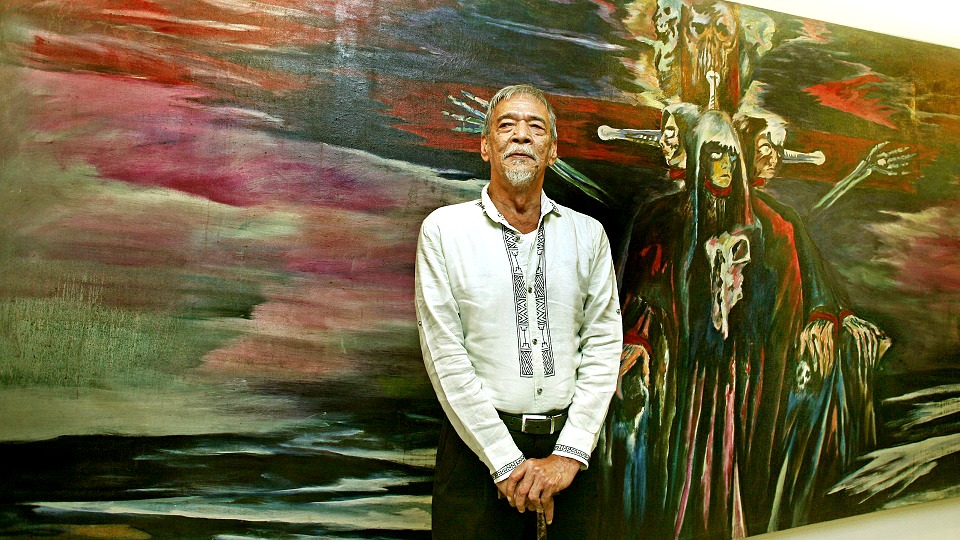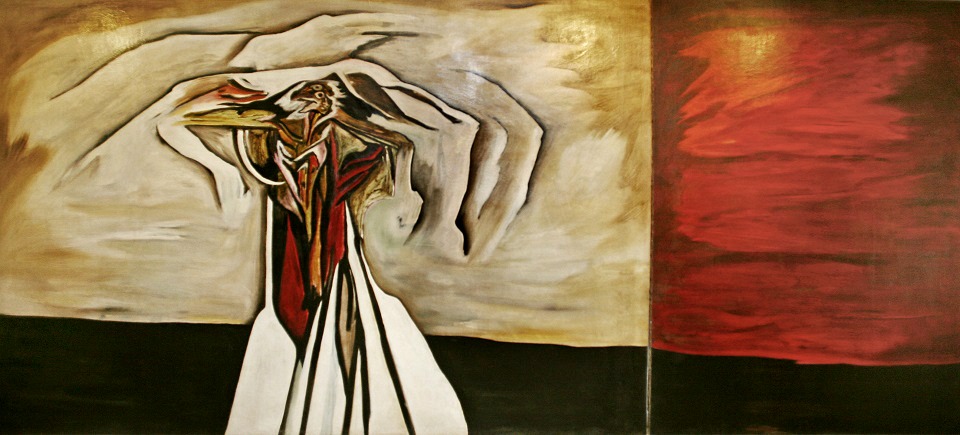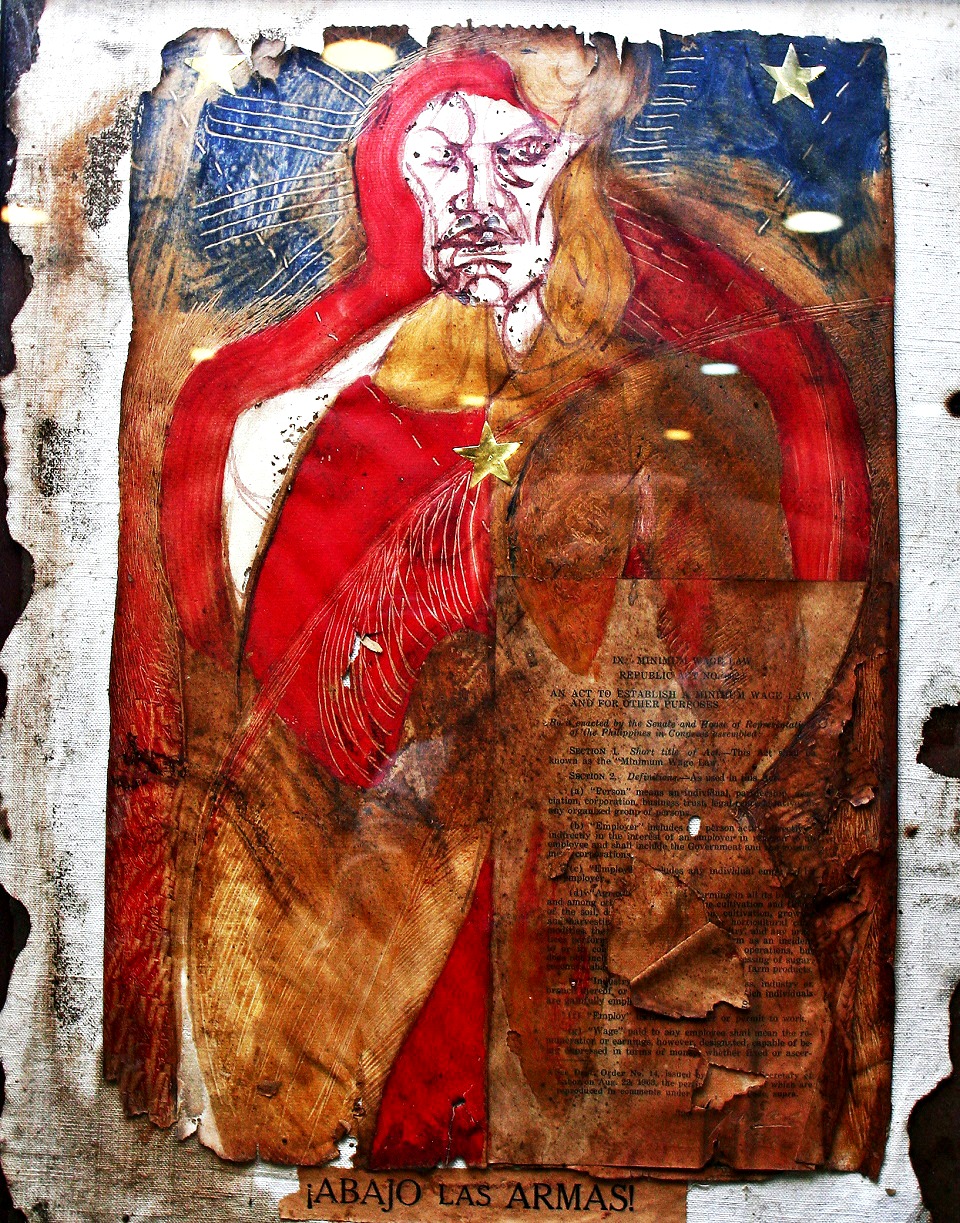Filtered By: Lifestyle
Lifestyle
Art review: Jaime de Guzman, meta artist
By FILIPINA LIPPI

Jaime de Guzman in front of his painting, 'Gomburza.' All photos by Pinggot Zulueta
“There is always an element of Dante Alighieri in me. My works are my journeys to hell and back. From the late 60s to the 70s, my colors in my socio-historical-psychological paintings works were angry, dark, and foreboding. Nowadays, I cannot use the color red. I don’t have anger anymore. I am happy. I have come to a full circle. I've settled down. And I accept all,” says de Guzman, adding the journey of his art and life is similar to the poet’s sojourn to infierno, purgatorio, and paradiso in Dante's “Divina Commedia.”
Assessing his latter artworks with images challenged by his search for transcendence and lost paradise for the past 25 years, he says, “Now, I am more concerned with radiance and personal mythologies. It is like being Ulysses, who came home to draw the bow. One finds the center when one draws the bow; when one sees the meeting of the bow and the arrow as the immoveable spot between war and peace. I am now painting the sound of the universe from that immoveable spot.”
De Guzman’s art and life – an odyssey from darkness to light – guided Emily Abrera and Victoria Herrera, Cultural Center of the Philippines (CCP) chair and director of visual arts, respectively, in mounting his retrospective show “Revelations,” which opened at CCP’s second floor on March 4. It will end on April 26.
Metamorphosis from the late 60s to the 70s

'Methamorphosis I', oil on canvas
“Gomburza,” is a riveting painting of Jose Burgos, Mariano Gomez and Jacinto Zamora, who were executed by Spanish authorities in 1872. In the painting are images of politicians, priests, the Statue of Liberty, Jose Rizal, and De Guzman’s family: the naked artist covered in leaves, his pregnant wife in a white robe, and their first son Fausto. The inclusion of his family in the painting is an intentional fusion of a happy existential life and a past era remembered with outrage and pain.
De Guzman’s early works from the late 60s to the 70s were shaped by strong reactions to the oppressive Spanish and American colonial eras and the blood of heroes spilled in failed revolutions. Belonging to a new generation of politically conscious artists in the post-colonial era who bathed their canvases with blood at the time, De Guzman made a difference by painting the past as if he was at the center of a cleansing ritual, as if its pain and suffering his personal experience, a psychological approach never explored by other expressionist-surrealist Filipino artists and social realist painters in the 70s.
“My paintings between the late 60s to the 70s were done during a crucial junction of our history. Since I’m not a political person, my artworks were more about my consciousness and personal expressions of freedom and oppression,” he says. Asked about his contribution to artists’ arduous search for Philippine identity in the 70s, he says, “Philippine identity will come out naturally whether you like it or not. You are your connection with your culture, history, and land. One cannot get away from that unless one does it willfully.”
Meeting Siquieros and Anne in Mexico in the 70s

'Abajo Las Armas', mixed media collage
Right after his Mexico sojourn, de Guzman painted the walls of Liliw’s municipal hall with folk images and flora fused with abstract lines and cubistic figures. He also started to paint Christ as a Filipino, igniting the image as a sane center for the colonized and the hybrid in search of their country’s long-lost cultural energy. A Philippine flag with two Christ-like figures is depicted in “Flores Para Dante” in 1971; Christ as everyman is shown in “Waiting for the Apostles”; Christ is a folk hero in “Historical Allegory” and a long-haired shaman with fireflies in “Pakulba.”
De Guzman also devoted his life to pottery, an art without ego. He and his wife raised seven children in places like Candelaria, Quezon, where they produced high-fired stone-wares that carried the name Mount Banahaw Pottery; and Sagada, where their seventh child was born in 1985. He still calls these places his paradise (of art and life). The couple held shows at galleries and hotels in Manila and abroad.
“Pottery is such a wonderful material and experience. It’s holistic, its elements akin to life,” De Guzman recalls. A poem he wrote in the 70s also animates his happiness with his family and pottery: The creative process does not stop/ when there are no walls to unwall/ There is always something to do/ Wedge the clay, invent a little/ It is good for the mind/ To feel the earth, to water it, to form it/ and be formed/ There is the fire/ In the night in harmony/ with the stars/ in the day as bright as the sun/ In a pot/ In a jewel/ from the fire.
Paradise lost, paradise regained
After his wife and grown-up children went to the US in the 1990s, de Guzman slowly returned to painting in between reading books and moments of introspection about taming the ego without pottery, sans clay in his hands and his kiln dismantled; about centering while crippling arthritis weakened his lower limbs. During this lonely period, he produced Philippine and Southeast Asian landscapes; “yoni-inspired” landscapes that approximate sacred places; landscapes of labyrinth, lotus, love and war; autobiographical landscapes shaped by his soul; and later, poetic abstract art works that also reflect his life.
Poetic abstraction
Interconnection is the theme of de Guzman’s poetic abstract works “Venus between Two Heartbeats” (2013) with images of the morning star and his own heartbeats graphed by ECG monitor; and “Quaternity” (2014) a surreal road off to a powerful sunrise on top of a blue sea. “In 'Venus' I’m trying to connect with my body. I am also inspired by the outer space, to connect with what is out there,” he says. “'Quaternity' is about art’s appeal.” Both works are seen as the start of a series of the artist’s abstract bio-paintings. All his recent works are more philosophical than visual, but they blind and lure with the beauty of the knowledge they impart. — BM, GMA News
Jaime De Guzman's retrospective exhibit “Revelations” is on display at the Cultural Center of the Philippines up to and including April 26.
More Videos
Most Popular



